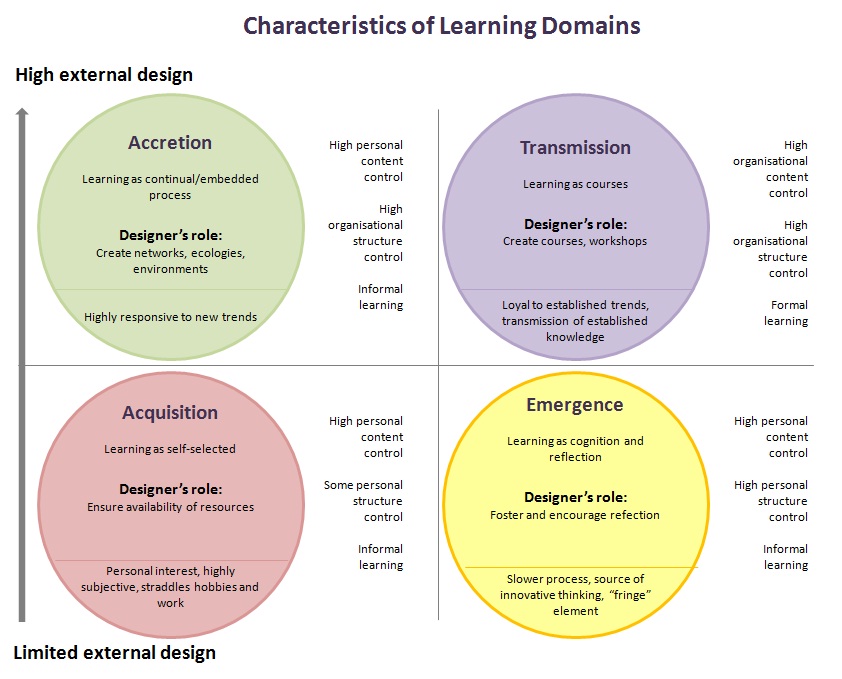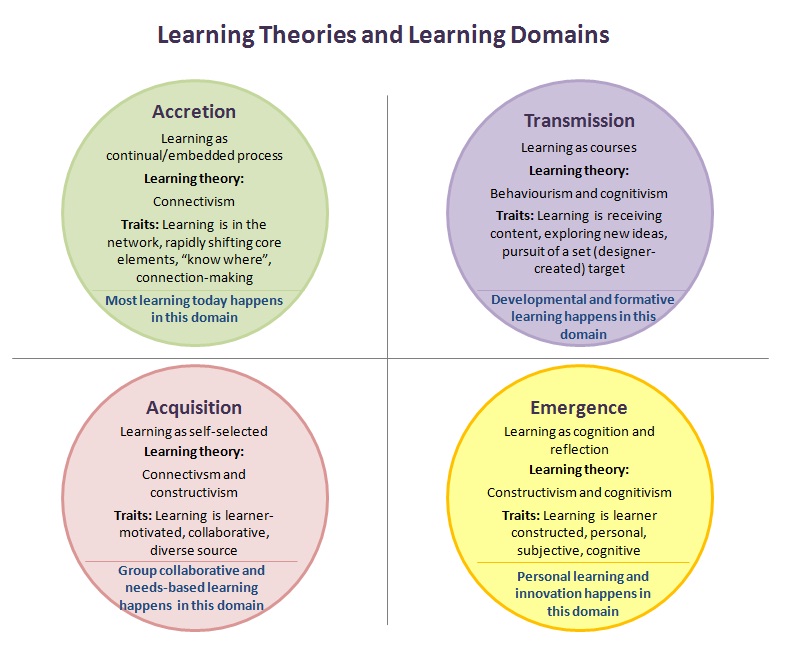Learning Theories and Learning Domains
Characteristics of learning domains
Each learning domain possesses certain characteristics in relation to the nature of learning, the role of the designer, and the level of control over content and structure. Figure 2.2 provides a summary of each learning domain and design influence which is discussed below.
(Source: George Siemens (2005) Learning Development Cycle: Bridging Learning Design and Modern Knowledge Needs.)
1. Transmission domain
The instructional process is the object of design in the transmission domain. Traditional instructional design models attend to transmission through focus on explicit learning objectives, content analysis, content sequencing, and blueprinting the instructional flow. This model has particular value in creating courses, programs, and workshops. The instructor (due to activities of the designer) is kept at the centre of the instructional process.
Transmission is particularly useful when introducing new bodies of knowledge or meeting compliance-training needs. Much of today's educational system is built on this model of learning. Education is constructed with start and end points (courses, programs, degrees). Learners are exposed to key ideas within a knowledge field by an instructor who is competent in the domain. Transmission occurs through readings, lectures, and more recently, group work and collaborative activities. Behaviourism and cognitivism are the predominant learning theories utilised in conjunction with the transmission domain of learning.
2. Emergence domain
The capacity for reflective and critical thinking is the object of design in the emergence domain. Emergence is a less common form of learning, but its effects are significant. In a sense, emergence opens doors to new fields of knowledge, leading into the selection of accretion or acquisition domains to continue knowledge development. Reflection and cognition provide learners with the capacity to explore new realms. Serendipitous learning is also an important aspect of the process. The formulation of innovative approaches and new perspectives are functions of emergence learning. Cognitivism and constructivism are the learning theories most reflective of how learning occurs in the emergent domain.
3. Acquisition domain
Access to resources is the object of design in the acquisition domain. Acquisition is a large part of learning. Designers also seek to improve the abilities of learners to manage and navigate knowledge resources. It is a largely unstructured process where learners select their own objectives and intent for learning. Often, personal interest is the motivating factor. Of all the learning domains, acquisition is the most "fun". Subject matter being explored is highly relevant to the learner's interest and use. Learners may reach beyond current resources to connect with others in the creation of virtual communities. The internet has made the formation of communities based on interest (not geography) possible. Connectivism (Siemens, 2004) and constructivism are the learning theories that most adequately inform the nature of acquisition learning.
4. Accretion domain
Networks, environments, and ecologies are the object of design in the accretion domain of learning. Most learning happens in this domain. Learning at this level is a function of creating connections, foraging for needed knowledge, and "plugging in" to learning sources (as compared to possessing learning). Knowing where to find needed information is valued above possessing information, due to how quickly information evolves and changes. The designer's role in this domain of learning is to create the construct and opportunities for learners to pursue and provide for their own learning. The network itself is the critical learning element. Connecting learners to networks and communities ensures that knowledge is relevant and current.

Figure 2.2 Characteristics of learning domains
Source: George Siemens (2005)
Most models assume that the creation of an instructional process is the intent of design. This view only addresses the transmission domain of learning. The domains of accretion, emergence and acquisition are often unattended in traditional design. As previously stated, each domain has different object of design. Each different design object is indicative of a different view or theory of learning. Figure 2.3 expresses the link between learning domain and suited learning theory.
Figure 2.3 Learning Theories and Domains
Source: George Siemens (2005) Learning Development Cycle: Bridging Learning Design and Modern Knowledge Needs.
- Accretion Domain:
- Transmission Domain:
- Acquisition Domain:
- Emergence Domain:
Licensed under the Creative Commons Attribution 3.0 License
